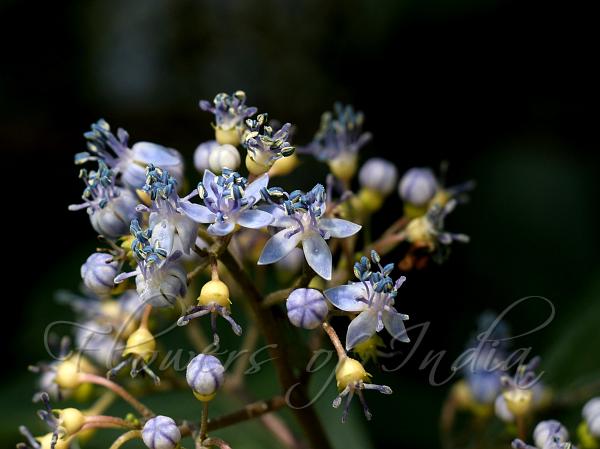|
| Blue Himalayan Hydrangea |
|

|

| File size | 399449 |
| Original date | 5/23/16 11:46 AM |
| Resolution | 0 x 0 |
| Flash | Flash did not fire, auto |
| Focal length | 135.0mm |
| Exposure time | 1/125s |
| Aperture | 9.0 |
| Focus Distance | |
| Metering Mode | Multi-segment |
| Camera make | Canon |
| Camera model | Canon EOS REBEL T4i |
| Sensor type |
|
|
|
|
Photo: |
Botanical name: Hydrangea febrifuga Family: Hydrangeaceae (Hydrangea family)
Synonyms: Hydrangea pubescens, Dichroa febrifuga
Synonyms: Hydrangea pubescens, Dichroa febrifuga
Blue Himalayan Hydrangea is shrub 1-2 m tall. Blue
flowers are borne in corymb-like panicles, 3-20 cm across. Flower buds
are obovoid, 6-10 mm; flower-stalk 3-5 mm. Sepals 4-6, broadly
triangular, tip pointed. Petals are turned back at maturity, blue or
white, oblong-elliptic, slightly fleshy. Stamens 10-20; filaments fused
when young, free at maturity, thread-like; anthers ellipsoid. Styles
are 4-6, club-shaped; stigma oblong. Branchlets, leaf-stalks, and veins
are hairless or crisped velvet-hairy. Leaf-stalks are 1.5-5 cm; leaf
blade sometimes purplish below, elliptic, obovate, elliptic-oblong, or
lanceshaped, 6-25 x 2-10 cm, papery, below hairless or crisped
velvet-hairy along veins, rarely sparsely hairy, above hairless,
secondary veins 8-10 on both sides of midvein, base wedge-shaped,
margin sawtoothed to coarsely so, rarely wavy, tip pointed to tapering.
Berry is dark blue when mature, 3-7 mm in diameter. Seeds are about l
mm. Blue Himalayan Hydrangea is found in Eastern Himalayas, from C
Nepal to China, SE Asia, at altutudes of 900-2400 m. Flowering:
May-July.
Medicinal uses: It is an important herb in
traditional Chinese medicine, where it is considered one of the 50
fundamental herbs. The active ingredients are febrifugine and
isofebrifugine. In traditional preparations it is used in conjunction
with other plants such as Glycyrrhiza glabra, Ziziphus jujube and
ginger.
It is an important herb in
traditional Chinese medicine, where it is considered one of the 50
fundamental herbs. The active ingredients are febrifugine and
isofebrifugine. In traditional preparations it is used in conjunction
with other plants such as Glycyrrhiza glabra, Ziziphus jujube and
ginger.
Medicinal uses:
 It is an important herb in
traditional Chinese medicine, where it is considered one of the 50
fundamental herbs. The active ingredients are febrifugine and
isofebrifugine. In traditional preparations it is used in conjunction
with other plants such as Glycyrrhiza glabra, Ziziphus jujube and
ginger.
It is an important herb in
traditional Chinese medicine, where it is considered one of the 50
fundamental herbs. The active ingredients are febrifugine and
isofebrifugine. In traditional preparations it is used in conjunction
with other plants such as Glycyrrhiza glabra, Ziziphus jujube and
ginger. | Identification credit: Siddarth Machado | Photographed in Sikkim. |
• Is this flower misidentified? If yes,